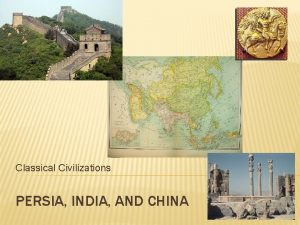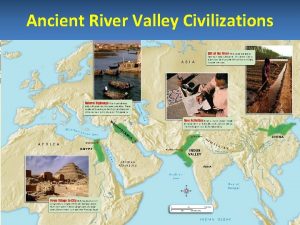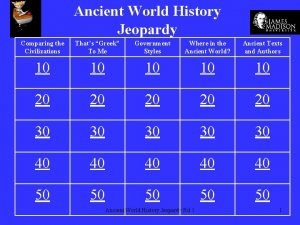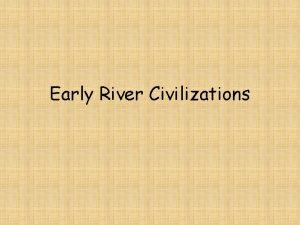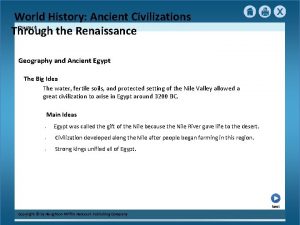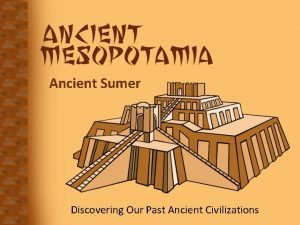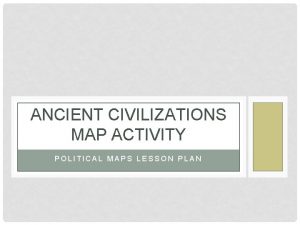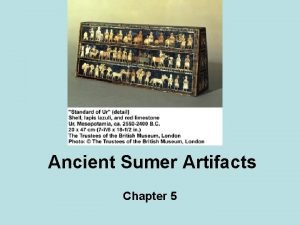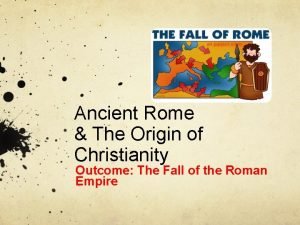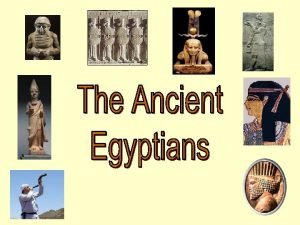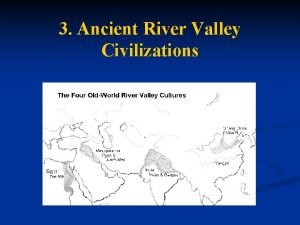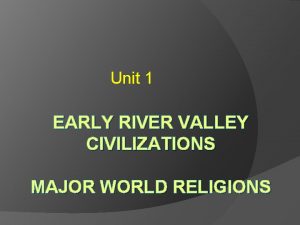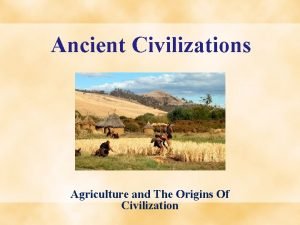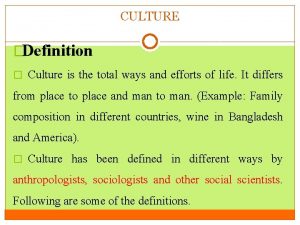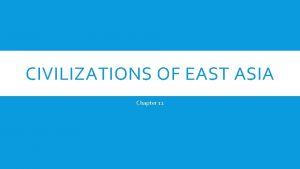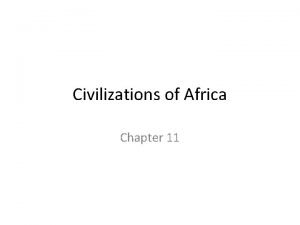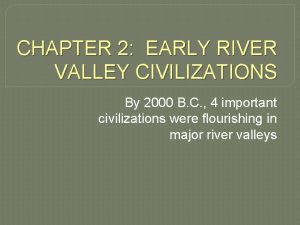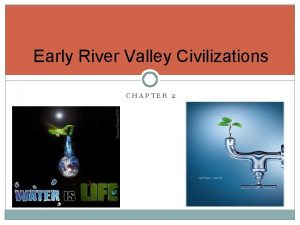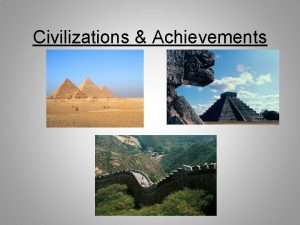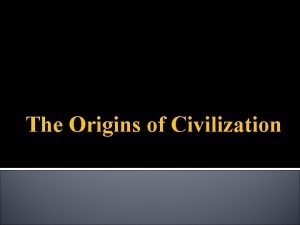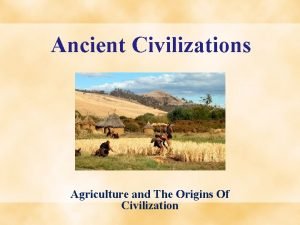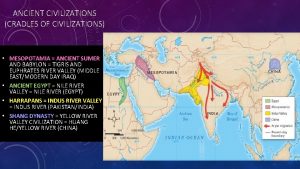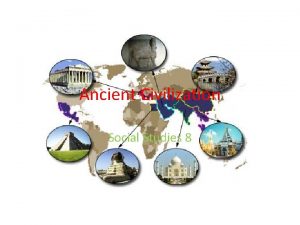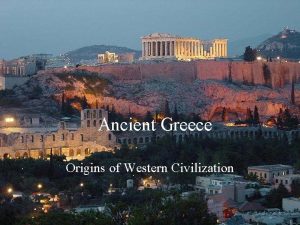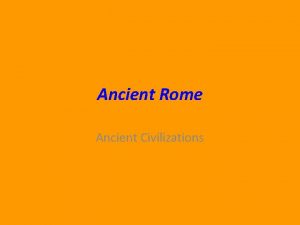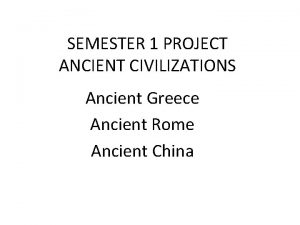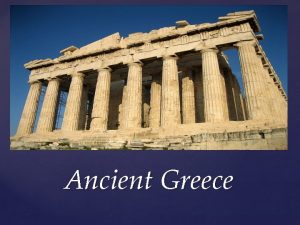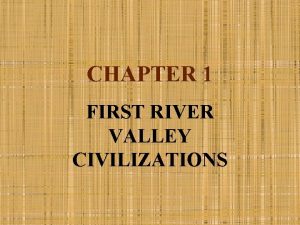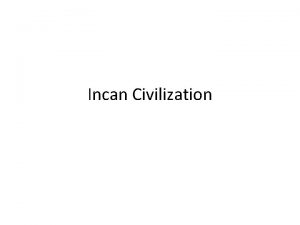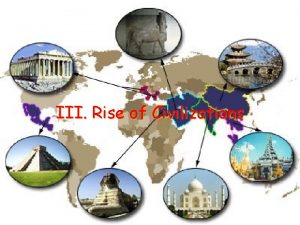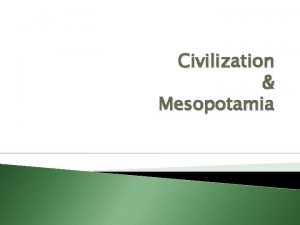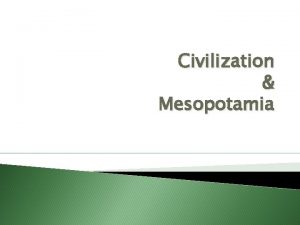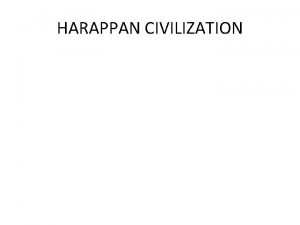Ancient Civilizations Chapter 2 Origins of Civilization cultural
























- Slides: 24

Ancient Civilizations

Chapter 2: Origins of Civilization cultural hearth---new ideas, practices and technology began in places called cultural hearths Four Cultural Hearths— 8, 000 -5, 000 B. C. 1. Mesoamerica: Oaxaca---Farmers in Oaxaca introduced an important new crop called maize (corn). 2. North Africa: Faiyum---Faiyum farmers adopted techniques from cultures across the Mediterranean--storage pits for grain, domestication of animals, etc. . . 3. Southwest Asia: Catalhoyuk---Builders at Catalhoyuk demonstrated advanced construction techniques. 4. China: Banpo---Yangshao potters at Banpo created functional, beautiful pottery.

Cradle of Civilization Hunter-gatherer---During the Paleolithic time, there were no farms or stores. Humans lived as hunter-gatherers meaning that they would hunt animals and gather wild plants to eat. They worked together and shared jobs (specialization), and groups were usually about 30 people. Nomads---Because the animal herds moved with the seasons, so did the groups hunting them. People who moved from place to place were called nomads or nomadic hunter-gatherers. Domestication---In time, people stopped moving around. They learned to grow their own gardens or farms and tame animals. This is called domestication.

Cradle of Civilization Cont. Civilization---An advanced stage of human society that includes building towns, government, religion, art, science, and a written language. Civilizations began about 6, 000 years ago in an area called the Fertile Crescent or Cradle of Civilization in Mesopotamia which means “land between the rivers”. (see map on page 67) The rivers were the Tigris and Euphrates Rivers.

The Sumerians Mesopotamia’s first civilization was called Sumer and was built on the Tigris and Euphrates Rivers. It was made up of 12 city-states which were self-governed. Innovation or contribution or technology--A new way of doing something that was of use to future societies.

The Sumerians Cont. Sumerian Innovations: Irrigation---The Sumerians built walls of dirt to trap water, and canals carried the water to their farm lands. Wheel and wheeled cart---Sumerian farmers made wheels so they could move construction materials and used domesticated animals (ox or donkey) to pull carts. Cuneiform---Sumerians developed this form of writing by pressing wedge-shaped reeds into wet clay tablets. Iqu or acre---A unit of land measurement invented by Sumerians. Boats with sails---These were used to carry cargo down the rivers with the help of the wind to power them. Quart---Sumerians used this measurement for barley and wheat

The Sumerians Cont. Land of Many Gods Sumerians worshipped hundreds of gods. This belief is called polytheism. They believed these gods controlled nature, animals, weather, flooding, etc… City-states were important religious centers. The most important building within a city-state was a huge pyramidshaped temple called a ziggurat. Ziggurat means “mountaintop” and was dedicated to a deity or god/goddess.

Sargon the Conqueror Mesopotamian ruler and first emperor of the Fertile Crescent He built the capital city of Akkad His empire lasted for 150 years, he ruled for 56 years Sargon was an effective warrior and skilled at managing people and projects

The Babylonians Hammurabi---First ruler to write down a Code of Laws and was the 6 th king of Babylon (and the most powerful) He had 282 laws carved on a stone pillar The laws were applied based on a person’s social class and favored the upper class He set rules for land, families, marriages, fair prices, theft, taxes, etc…---eye for an eye

The Assyrians and the Chaldeans The Assyrians lived in northern Mesopotamia and were united by their worship of the god Ashur. They were fierce warriors and used strong, destructive iron weapons. Assyrian contributions: Built first system of roads Had a postal service with messengers to deliver clay tablets Started a library that contained thousands of clay tablets

The Assyrians and the Chaldeans Overtake the Assyrians Nebuchadnezzar II was the most famous Chaldean king His rule lasted 43 years over the Babylonian Empire Considered a cruel king His most famous accomplishment was the Hanging Gardens of Babylon---a terraced mountain of plants that used irrigation

The Phoenicians Lived along coast of the eastern Mediterranean Sea with good harbors for trading using ships Phoenicians means “purple dye people” because of the local shellfish that they processed into a purple dye used to color fabric This dye was their most famous trade good along with cedar wood Skilled ship builders and fearless sailors They developed a 22 letter alphabet to use for record keeping Militarily weak

Persian Leaders Persia was located in what is present day Iran just east of Mesopotamia Cyrus the Great was a Persian king and his secret to success was tolerance and sympathy for the beliefs and practices of the people he captured After Cyrus’s death, his son ruled and then the next king was Darius I who was a wise ruler Darius I divided his empire into 20 smaller provinces or administrative districts that were ruled by governors call satraps who helped him maintain control of his huge empire

The Lydians At first people bartered----exchanging/trading one good or service for another The Lydians were the first people to use coined money made by their government It was light enough to carry, made from gold/silver and stamped with the mark of the king of Lydia The use of money allowed people to set prices for goods and services

Judaism and the Israelite Kingdoms Abraham and Moses The Hebrews or Israelites were a people who settled in Canaan/Israel/the Promised Land which was on the eastern coast of the Mediterranean Sea The Hebrews differed from all other ancient people because they practiced monotheism, the worship of one God Abraham, a Mesopotamian shepherd was told by God to take his family to Canaan According to the Bible, there was a terrible drought and the Hebrews left Canaan and settled in northern Egypt and the pharaoh of Egypt made them all slaves God chose Moses to help them escape from Egypt Moses climbed to the top of Mount Sinai where God gave him the Ten Commandments or religious laws to live by

Judaism and the Israelite Kingdoms Cont. Jewish Beliefs and Practices The Hebrew Bible/Torah describes how Moses taught a religious code that governed the lives of the Israelites The religion of Judaism stresses the importance of treating others well, promots justice, equality and the holiness of human life Jews worship in buildings called synagogues meaning “places of assembly” A spiritual leader called a rabbi or teacher usually conducts services

The Ancient Chinese and Confucius Natural Barriers Ancient China was somewhat isolated or cut off from the rest of the world and had relatively no outside cultural influence China’s civilization arose along two fertile river valleys--the Huang He and the Chang Jiang Rivers

The Ancient Chinese and Confucius China’s First Dynasty The Shang dynasty emerged along the banks of the Huang He River around 1600 B. C. A dynasty is a line of rulers from the same family The Shang developed a system of writing using about 3, 000 characters. They first appeared on oracle bones, which are animal bones used to consult the many gods the Shang people worshipped. Priests carved a question on a bone and then heated it. They believed the pattern of the cracks revealed the gods’ answer. The Zhou dynasty overthrew the Shang dynasty The Zhou developed a concept known as the Mandate of Heaven which meant that a king could rule as long as the gods believed he was worthy. So this led to ruling dynasties changing called a dynastic cycle.

The Ancient Chinese and Confucius Chinese Philosophies v Confucianism---Beliefs based on the teachings of Confucius. He taught people to respect authority & one another, and filial piety or the respect children owe their parents, elders and ancestors. v Daoism---A belief system based on a man named Laozi that emphasizes living in harmony with nature and the Dao means “the Way” and is believed to be the driving force behind everything that exists. Daoists seek order and balance in their lives by blending with nature----Yin (dark, cold, soft, water) and Yang (light, hot, hard, fire).

The Ancient Chinese and Confucius Routes Across Asia Silk Roads---A series of international trade routes is one of China’s great legacies. Silk was the main good that China traded on the routes and this brought great wealth to China.

Ancient India, Hinduism and Buddha Well-Planned Cities in India Civilizations developed in the Indus Valley Mohenjo-Daro ---a major city that covered over 250 acres Harappa---another important city Both cities---surrounded by walls, straight road that intersected at right angles, brick houses, indoor plumbing with a bathroom and toilet, sewer system, writing system, long-distance traders using boats and wheeled carts A combination of events caused these cities to be abandoned---flooding, drought, earthquakes, no food, no irrigation, etc… The two most important riversin India were the Ganges and Indus Rivers.

Ancient India, Hinduism and Buddha Aryan Migration New migrant tribes came to India called Aryans which means “noble ones” Aryans were seminomadic herders of horses and cattle and were fierce warriors Aryans worshipped many gods from nature and friendship. To keep their gods happy, Aryan priests of Brahmans, performed complicated rituals in Sanskrit, the Aryan language. Their religion came to be called Brahmanism. A social class or caste system that determined how people lived developed that was hereditary (born into) and could never be changed. Top to bottom----1. priests----2. warriors & nobles----3. freemen, farmers & traders----4. slaves, laborers, artisans, & non-Aryans

Ancient India, Hinduism and Buddha Hindu Beliefs and Practices The religion that grew out of Aryan beliefs and practices is Hinduism Reincarnation is the belief that the soul is eternal and is reborn in different bodies over different life cycles According to Hindu beliefs, people’s actions and conduct create karma, which determines the kind of life into which they will be reborn Living a good life equals being reborn into a better life— good karma Living a life of misdeeds creates bad karma, which leads to rebirth into a life of great suffering

Ancient India, Hinduism and Buddha Siddhartha Gautama and Buddhism is a religion based on the teachings of Siddhartha Gautama He was a prince who lived a life of luxury He gave up his wealth, his wife and his child in search of why people suffered and what made people happy He wandered for six years and meditated and finally understood how to be free of suffering Siddhartha became known as the Buddha or “Enlightened One” Buddha taught that if you led a good life it would lead to nirvana or a state of bliss/joy Buddha’s teachings are known as the dharma or divine law
 Ancient river valley civilizations map
Ancient river valley civilizations map Lesson 1 early civilizations
Lesson 1 early civilizations The two classical civilizations of ancient india were the
The two classical civilizations of ancient india were the Ancient river valley civilizations powerpoint
Ancient river valley civilizations powerpoint Ap world jeopardy
Ap world jeopardy What river is this
What river is this World history ancient civilizations through the renaissance
World history ancient civilizations through the renaissance Discovering our past ancient civilizations
Discovering our past ancient civilizations Four corners of civilization map
Four corners of civilization map Sumerian stable food supply
Sumerian stable food supply Halloween has its origins in which ancient celtic festival
Halloween has its origins in which ancient celtic festival Ancient rome and the origins of christianity
Ancient rome and the origins of christianity Ancient egypt civilization geography
Ancient egypt civilization geography River valley civilizations definition
River valley civilizations definition Ancient egypt civilization
Ancient egypt civilization Ancient civilization agriculture
Ancient civilization agriculture Non material culture definition
Non material culture definition Guided reading activity civilizations of east asia
Guided reading activity civilizations of east asia Chapter 11 section 1 early civilizations of africa
Chapter 11 section 1 early civilizations of africa Machu picchu and mesa verde similarities
Machu picchu and mesa verde similarities River valley civilizations def
River valley civilizations def Chapter 2 early river valley civilizations
Chapter 2 early river valley civilizations Chapter 26 civilizations in crisis the ottoman empire
Chapter 26 civilizations in crisis the ottoman empire Ancient communication devices
Ancient communication devices Ancient india vs ancient china
Ancient india vs ancient china


